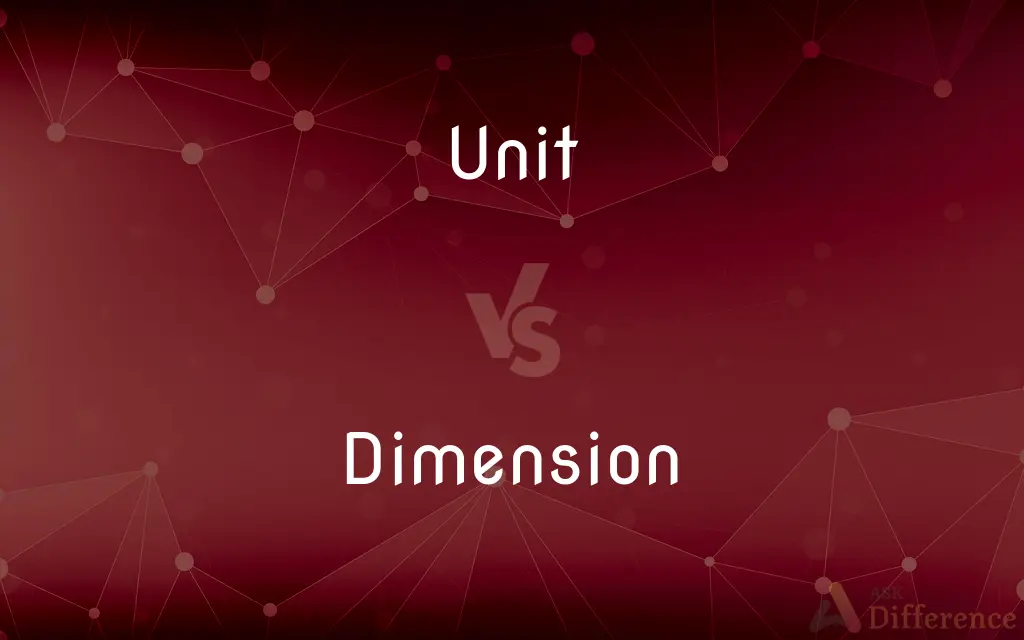Unit vs. Dimension — What's the Difference?
By Urooj Arif & Fiza Rafique — Published on April 19, 2024
Units are specific measurements for quantities (e.g., meters for length, kilograms for mass), while dimensions refer to the nature of a quantity (e.g., length, mass, time) without specifying the unit.

Difference Between Unit and Dimension
Table of Contents
ADVERTISEMENT
Key Differences
Units are standardized quantities used to specify the measurement of a physical quantity. They provide a reference for measurements, allowing clear communication and understanding of the magnitude of quantities. For example, length can be measured in units such as meters, feet, or miles. On the other hand, dimensions represent the type of quantity being measured, such as length, mass, or time, without indicating the magnitude. Dimensions are fundamental concepts in physics and mathematics that describe the nature of a physical quantity.
Units allow for the precise measurement and comparison of physical quantities. They are essential for scientific experiments, engineering, and daily life, enabling consistency in measurements across different contexts and regions. For instance, the meter is defined as the distance light travels in vacuum in 1/299,792,458 of a second, providing a universal standard for measuring length.
Dimensions, however, are conceptual and do not depend on specific units. They help in understanding the physical properties that a quantity represents and play a crucial role in dimensional analysis—a method used to check the consistency of equations and to derive relationships between physical quantities. Dimensions are represented by symbols (e.g., L for length, M for mass, T for time) and are used in mathematical expressions to denote the nature of a quantity.
The relationship between units and dimensions is foundational in converting measurements from one system of units to another (e.g., from the metric system to the imperial system) and in scaling measurements up or down. This is achieved by using conversion factors that relate different units of the same dimension (e.g., 1 inch = 2.54 centimeters).
While units are diverse and can vary based on the measurement system (metric, imperial, etc.), dimensions are universal and consistent across different fields of study. Understanding both concepts is crucial for accurately measuring, describing, and analyzing physical phenomena.
ADVERTISEMENT
Comparison Chart
Definition
Standardized quantities for measuring physical quantities.
The nature of a physical quantity, indicating what it measures.
Examples
Meters (length), kilograms (mass), seconds (time)
Length, Mass, Time
Role
Provide a reference for measurements, allowing for precise comparison.
Describe the type of quantity without specifying magnitude.
Dependency
Vary by measurement system (e.g., metric, imperial).
Universal and consistent across different fields of study.
Application
Used in daily life, science, and engineering for precise measurements.
Used in dimensional analysis to check equations' consistency and derive relationships between quantities.
Representation
Expressed by specific symbols (e.g., m, kg, s).
Represented by generic symbols (e.g., L for length, M for mass).
Compare with Definitions
Unit
A unit of length in the metric system.
The room is 5 meters long.
Dimension
A dimension that quantifies the amount of matter in an object.
Mass is a fundamental dimension in physics for understanding weight and inertia.
Unit
A unit of mass in the metric system.
The package weighs 2 kilograms.
Dimension
A dimension representing the measurement of space.
The dimension of length is crucial in calculating area and volume.
Unit
A unit of electric current in the International System of Units.
The device draws a current of 2 amperes.
Dimension
A dimension used to quantify the progression of events.
Time is essential in calculating speed and acceleration.
Unit
A unit of thermodynamic temperature.
Water freezes at 273.15 kelvins.
Dimension
A dimension that quantifies the concept of hot and cold.
Temperature plays a vital role in chemical reactions and state changes of matter.
Unit
A unit of time universally recognized.
The event lasted 60 seconds.
Dimension
A dimension representing the flow of electric charge.
Electric current is key in the study of circuits and electrical systems.
Unit
An entire apparatus or the equipment that performs a specific function.
Dimension
A measure of spatial extent, especially width, height, or length.
Unit
A precisely specified quantity in terms of which the magnitudes of other quantities of the same kind can be stated.
Dimension
Often dimensions Extent or magnitude; scope
A problem of alarming dimensions.
Unit
Any determinate amount or quantity (as of length, time, heat, value) adopted as a standard of measurement for other amounts or quantities of the same kind.
Dimension
(Physics) A physical property, such as mass, distance, time, or a combination thereof, regarded as a fundamental measure of a physical quantity
Velocity has the dimension of distance divided by time.
Dimension
(physics) One of the physical properties that are regarded as fundamental measures of a physical quantity, such as mass, length and time.
The dimension of velocity is length divided by time.
Dimension
The degree of manifoldness of a quantity; as, time is quantity having one dimension; volume has three dimensions, relative to extension.
Dimension
A literal factor, as numbered in characterizing a term. The term dimensions forms with the cardinal numbers a phrase equivalent to degree with the ordinal; thus, a2b2c is a term of five dimensions, or of the fifth degree.
Dimension
The magnitude of something in a particular direction (especially length or width or height)
Dimension
One of three cartesian coordinates that determine a position in space
Dimension
Shape or form to required dimensions
Common Curiosities
Are dimensions universal?
Yes, dimensions are universal concepts that apply consistently across different fields of study, regardless of the measurement system used.
How do units and dimensions relate to each other?
Units provide specific measures within the framework defined by dimensions, allowing for precise and consistent measurements.
Can the same dimension have different units?
Yes, the same dimension can be measured in different units (e.g., length in meters or feet).
Can units be converted?
Units can be converted within the same dimension using conversion factors (e.g., from inches to centimeters for length).
What role do units play in everyday life?
Units allow for the precise measurement and communication of quantities in everyday life, science, and engineering.
Why are dimensions important in science?
Dimensions are crucial for understanding the properties of physical quantities and for performing dimensional analysis to verify the consistency of equations.
What is dimensional analysis?
Dimensional analysis is a method used to check the consistency of physical equations by analyzing the dimensions of the quantities involved.
Why might units vary by region or country?
Units can vary due to historical, cultural, and practical reasons, leading to the use of different measurement systems (e.g., metric vs. imperial).
What is the difference between a unit and a dimension?
A unit is a standardized measure of a physical quantity, while a dimension indicates the nature or type of the quantity being measured.
How do you determine the dimension of a physical quantity?
The dimension of a physical quantity is determined by its fundamental properties, such as length, mass, or time.
Share Your Discovery

Previous Comparison
Deep Tissue vs. Remedial Massage
Next Comparison
Free Software vs. Open Source SoftwareAuthor Spotlight
Written by
Urooj ArifUrooj is a skilled content writer at Ask Difference, known for her exceptional ability to simplify complex topics into engaging and informative content. With a passion for research and a flair for clear, concise writing, she consistently delivers articles that resonate with our diverse audience.
Co-written by
Fiza RafiqueFiza Rafique is a skilled content writer at AskDifference.com, where she meticulously refines and enhances written pieces. Drawing from her vast editorial expertise, Fiza ensures clarity, accuracy, and precision in every article. Passionate about language, she continually seeks to elevate the quality of content for readers worldwide.













































